One to one maths interventions built for KS4 success
Weekly online one to one GCSE maths revision lessons now available
In order to access this I need to be confident with:
Area of a rectangle 3D shapes Faces, edges and vertices DecimalsThis topic is relevant for:

Surface Area Of A Cuboid
Here we will learn about the surface area of a cuboid and how to calculate it.
There are also volume and surface area of a cuboid worksheets based on Edexcel, AQA and OCR exam questions, along with further guidance on where to go next if you’re still stuck.
What is the surface area of a cuboid?
The surface area of a cuboid is the total area of all of the faces of a cuboid (or rectangular prism).
The 3 dimensions of a cuboid are width, length and height.
Cuboids have three pairs of identical faces – top and bottom, front and back, and left and right.
To work out the total surface area of a cuboid, we need to work out the area of each rectangular face and add them all together.
E.g. Find the surface area of a cuboid.
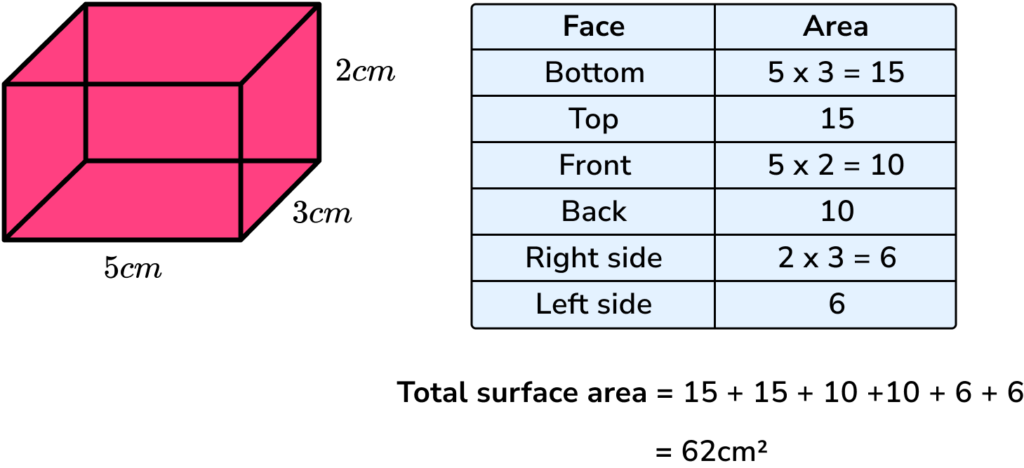
Since it is an area, surface area is measured in square units (e.g. mm^2, cm^2, m^2 etc).
What is the surface area of a cuboid?
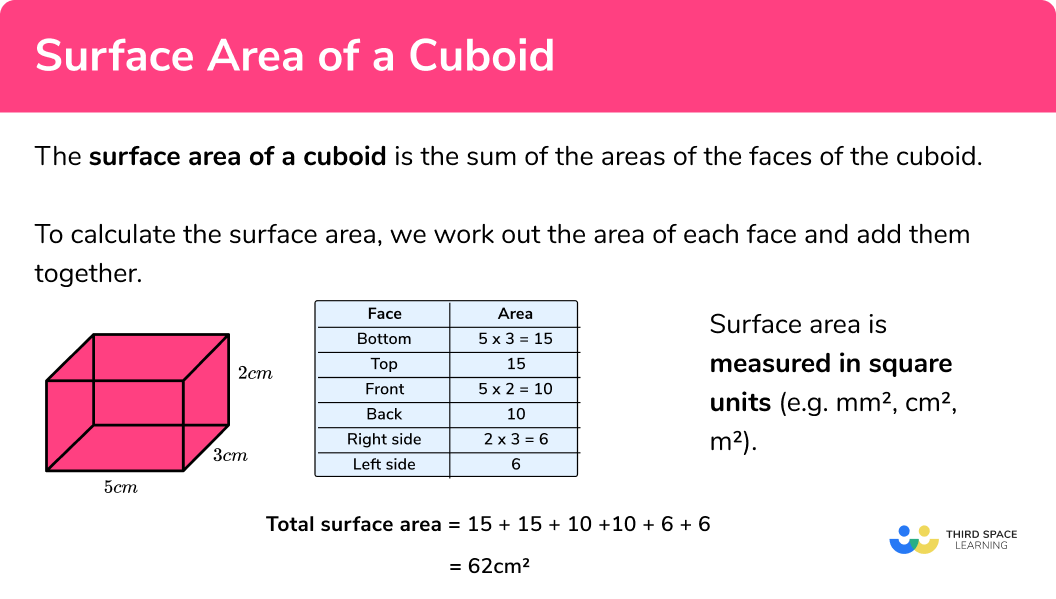
How to calculate the surface area of a cuboid
In order to work out the surface area of a cuboid:
- Work out the area of each face.
- Add the six areas together.
- Include the units.
How to calculate the surface area of a cuboid
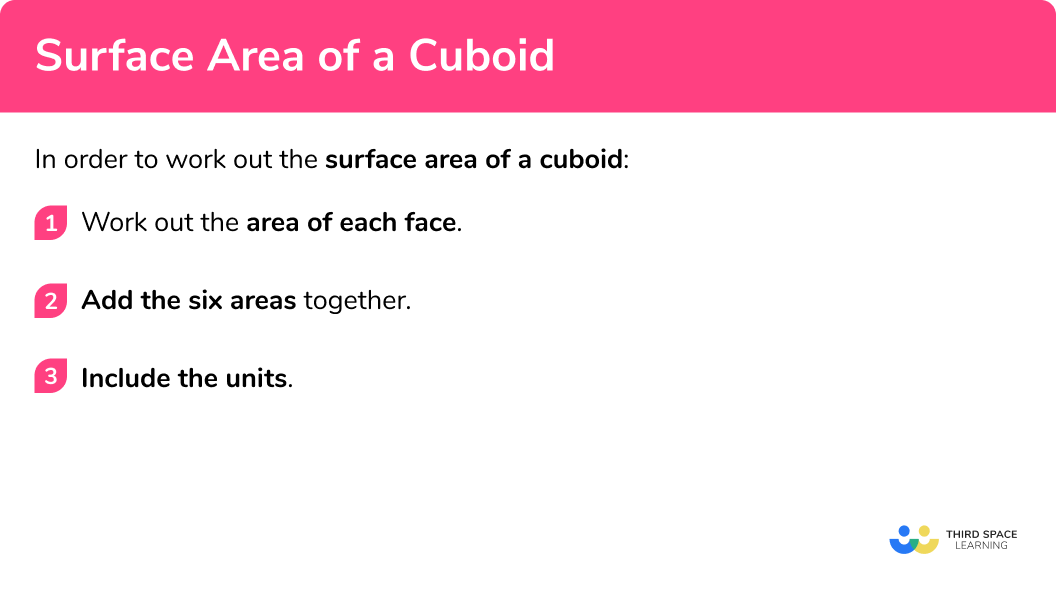
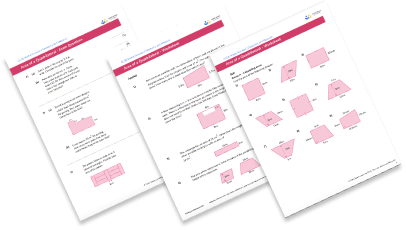
Surface area of a cuboid worksheet

Get your free surface area of a cuboid worksheet of 20+ questions and answers. Includes reasoning and applied questions.
DOWNLOAD FREE
Surface area of a cuboid worksheet

Get your free surface area of a cuboid worksheet of 20+ questions and answers. Includes reasoning and applied questions.
DOWNLOAD FREESurface area of a cuboid examples
Example 1: surface area of a cuboid
Work out the surface area of the cuboid
- Work out the area of each face.
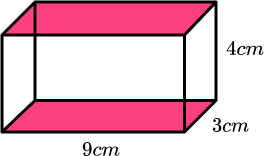
The area of the bottom is 9\times3=27cm^2 .
The top face is the same as the bottom face so the area of the top is also 27cm^2 .
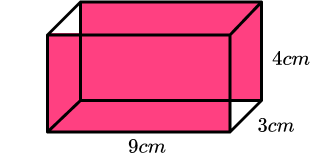
The area of the front is 9\times4=36cm^2 .
The back face is the same as the front face so the area of the back is also 36cm^2 .
The area of the right hand side is 3\times4=12cm^2 .
The left side face is the same as the right side face so the area of the left side is also 12cm^2 .
It will make our working clearer if we use a table:
| Face | Area |
| Bottom | 9×3=27 |
| Top | 27 |
| Front | 9×4=36 |
| Back | 36 |
| Right side | 3×4=12 |
| Left side | 12 |
2Add the six areas together.
The sum of the areas is: 27+27+36+36+12+12=150
3Include the units.
The measurements on the cuboid are in cm therefore the total surface area of the cuboid = 150cm^2 .
Example 2: surface area of a cuboid
Work out the surface area of the cuboid
Work out the area of each face.
| Face | Area |
| Bottom | 6×3=18 |
| Top | 18 |
| Front | 9×6=54 |
| Back | 54 |
| Right side | 9×3=27 |
| Left side | 27 |
Add the six areas together.
Include the units.
The measurements on the cuboid are in mm therefore the total surface area of the cuboid = 198mm^2 .
Example 3: surface area of a cube
Work out the surface area of this cube
Work out the area of each face.
Each face of a cube is the same. For this cube, the area of each face is 8\times8=64cm^2
Add the six areas together.
Include the units.
The measurements on the cube are in cm therefore the total surface area of the cube = 384cm^2 .
Example 4: surface area with different units
Work out the surface area of this cuboid
Work out the area of each face.
Notice that one of the measurements is in metres and the rest are in centimetres. Before we can calculate any areas, we need to ensure all units are the same. In this case, 0.1m=10cm so we can use 10cm .
| Face | Area |
| Bottom | 8×10=80 |
| Top | 80 |
| Front | 8×2.5=20 |
| Back | 20 |
| Right side | 10×2.5=25 |
| Left side | 25 |
Add the six areas together.
Include the units.
The measurements we have used are in cm therefore the total surface area = 250cm^2 .
Example 5: surface area using algebra
Work out the surface area of this cuboid.
Work out the area of each face.
| Face | Area |
| Bottom | 14×x=14x |
| Top | 14x |
| Front | 14×6=84 |
| Back | 84 |
| Right side | 6×x=6x |
| Left side | 6x |
Add the six areas together.
Include the units.
The measurements we have used are in cm therefore the total surface area = (40x+168) cm^2 .
If we are told the value of the surface area, we can use the expression we have found to work out the value of x .
Let’s say the surface area of this cuboid is 328cm^2 . Then we can say:
40x+168=328 .
Now we can solve this equation:
40x+168=328 40x=160 x=4cmThe width of this cuboid is 4cm .
Example 6: surface area using algebra
Work out the surface area of this cuboid
Work out the area of each face.
| Face | Area |
| Bottom | 10×4y=40y |
| Top | 40y |
| Front | 10×2y=20y |
| Back | 20y |
| Right side | 2y×4y=8y2 |
| Left side | 8y2 |
Add the six areas together.
Include the units.
The measurements we have used are in m therefore the total surface area = (16y^2+120y) m^2 .
Common misconceptions
- Calculating volume instead of surface area
Volume and surface area are different things – volume is the space within the shape whereas surface area is the total area of the faces. To find surface area, we need to work out the area of each face and add them together.
- Equal faces
A common mistake is to think that four of the faces are equal.
E.g.
The first pair of faces are equal to each other.
The second pair of faces are equal to each other.
The third pair of faces are equal to each other.
Related lessons
Surface area of a cuboid is part of our series of lessons to support revision on cuboid. You may find it helpful to start with the main cuboid lesson for a summary of what to expect, or use the step by step guides below for further detail on individual topics. Other lessons in this series include:
Practice surface area of a cuboid questions
1. Work out the surface area of the cuboid




Work out the area of each of the six faces:
| Face | Area |
| Bottom | 7×15=105 |
| Top | 105 |
| Front | 3×15=45 |
| Back | 45 |
| Right side | 3×7=21 |
| Left side | 21 |
\text{Total surface area: }105+105+45+45+21+21=342\mathrm{cm}^{2}
2. Work out the surface area of this cube




Since it is a cube, all of the faces are the same. The area of each face is 4\times 4=16\mathrm{cm}^{2} . There are six identical faces therefore the total surface area of the cube is 6 \times 16=96 \mathrm{cm}^{2}
3. Work out the surface area of this cuboid




Some of the measurements are in m and one is in cm. We need all of the measurements to be in the same units so convert the metres to centimetres. 0.7m=70cm and 0.4m=40cm . Now we can calculate the areas:
| Face | Area |
| Bottom | 70×15=1050 |
| Top | 1050 |
| Front | 70×40=2800 |
| Back | 2800 |
| Right side | 40×15=600 |
| Left side | 600 |
\text{Total surface area: } 1050+1050+2800+2800+600+600=8900\mathrm{cm}^{2}
4. Work out the surface area of this cuboid




Work out the area of each of the six faces:
| Face | Area |
| Bottom | 5×a=5a |
| Top | 5a |
| Front | 3×a=3a |
| Back | 3a |
| Right side | 3×5=15 |
| Left side | 15 |
\text{Total surface area: } 5a+5a+3a+3a+15+15=(16a+30) \mathrm{cm}^{2}
5. Work out the surface area of the cuboid




Work out the area of each of the six faces:
| Face | Area |
| Bottom | 8×b=8b |
| Top | 8b |
| Front | b×2b=2b2 |
| Back | 2b2 |
| Right side | 8×2b=16b |
| Left side | 16b |
\text{Total surface area: }8b+8b+2b^{2}+2b^{2}+16b+16b=(4b^{2}+48b)mm^{2}
6. Given that the surface area of this cuboid is 142\mathrm{cm}^{2} find the value of x .




Work out the area of each of the six faces:
| Face | Area |
| Bottom | 7×x=7x |
| Top | 7x |
| Front | 3×x=3x |
| Back | 3x |
| Right side | 3×7=21 |
| Left side | 21 |
\text{Total surface area: }7x+7x+3x+3x+21+21=20x+42
Since we know the surface area is 142\mathrm{cm}^{2}
we can say:
20x+42=142\\
20x=100\\
x=5\mathrm{cm}
Surface area of a cuboid GCSE questions
1. Calculate the surface area of the cuboid.
(3 marks)
Two of:
12\times 3.5=42\\
12\times 4=48\\
4\times 3.5=14
(1)
42+42+48+48+14+14(1)
208\mathrm{cm}^{2}(1)
2. A breakfast cereal producer wants to produce a cereal box with a volume of 4800cm^3 . The company wants to use as little cardboard as possible for each box. Should they use box A or box B ? You must show your working.
(5 marks)
Box A surface area: 160+160+600+600+240+240
(1)
\text{Surface area }=2000\mathrm{cm}^{2}(1)
Box B surface area: 192+192+480+480+250+250
(1)
\text{Surface area }=1844\mathrm{cm}^{2}(1)
They should use box B
(1)
3. John wants to paint 4 identical doors, as shown below.
1 litre of paint will cover
10\mathrm{m}^{2}
John has 1 litre of paint. Does he have enough paint to cover all 4 doors? You must show your working.
(5 marks)
(1)
Surface area of 1 door: 0.03+0.03+1.2+1.2+0.1+0.1
(1)
\text{Surface area of 1 door }=2.66\mathrm{m}^{2}(1)
\text{Surface area of 4 doors: }4 \times 2.66=10.64\mathrm{m}^{2}(1)
No he does not have enough paint
(1)
Learning checklist
You have now learned how to:
- Calculate the surface area of a cuboid
- Use the properties of faces, surfaces, edges and vertices of cubes and cuboids to solve problems in 3D
The next lessons are
Still stuck?
Prepare your KS4 students for maths GCSEs success with Third Space Learning. Weekly online one to one GCSE maths revision lessons delivered by expert maths tutors.

Find out more about our GCSE maths tuition programme.